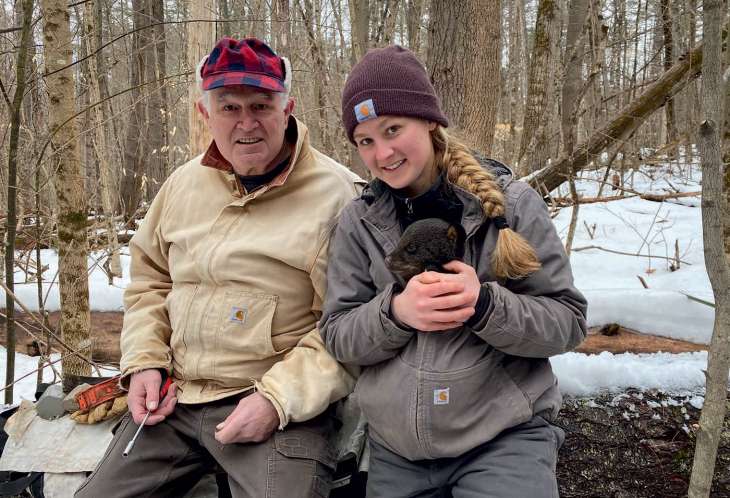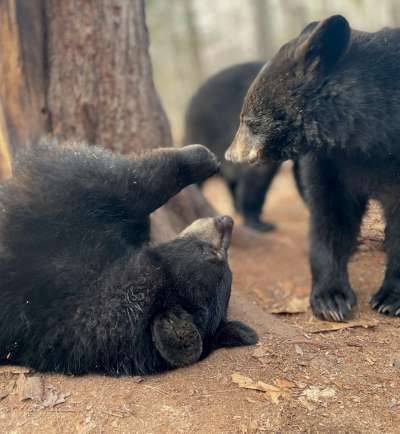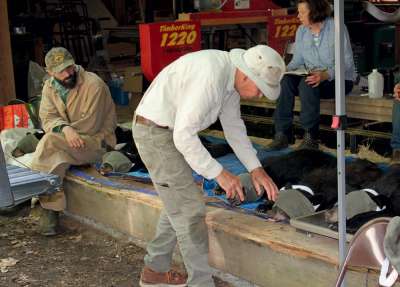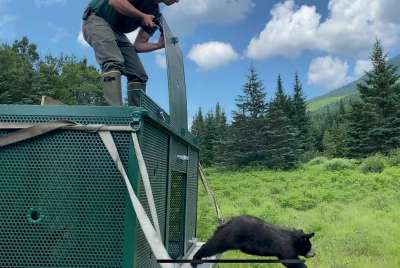
It’s a chilly morning, a few days after the spring equinox. The sun seems stronger than it did even a week ago, although snow still crunches underfoot. The forest is on the cusp of awakening. So are the bears, which is why I’m creeping through the woods in Lyme, New Hampshire, with a group of wildlife biologists. We’re making our way to a shallow den tucked beneath the root ball of a fallen tree, where a mother bear and her pair of 2-month-old cubs are curled up against the lingering chill.
The biologists, from New Hampshire Fish and Game, were able to locate the bears because the sow is wearing a collar that transmits a radio signal. That signal – and those from collars on two other female bears in the state – is tracked by the folks at the Kilham Bear Center, just up the road from this den. Center founder Ben Kilham could tell you a lot about this mother bear, whom he calls Wanda. He knows her age, how many cubs she’s had, the intricate details about where she wandered last spring, summer, and fall – and the seasons in years prior – and, of course, where she has situated her current den.
Perhaps as compelling as a wild bear named Wanda is the collaboration between the Kilham Bear Center and the state wildlife agencies it works with, including New Hampshire Fish and Game, Vermont Fish & Wildlife, and Massachusetts Division of Fisheries & Wildlife. Ben Kilham started studying bear behavior and social hierarchies – by accident, really – some 30 years ago, when a Vermont game warden brought him an orphaned cub. In the decades since, Kilham has rehabilitated and released some 600 bears – and written books and several academic papers about bear behavior. Meanwhile, wildlife biologists have come to rely on the center as a place where they can bring orphaned bear cubs and – eventually – return them to the forest.
“It’s a huge resource for us,” said Daniel Bailey, Bear Project leader for New Hampshire Fish and Game. “Without the Kilham Bear Center, we would have to make some tough decisions with these orphaned cubs. There may be no other option besides euthanizing some of them to end suffering. Especially cubs that are orphaned early on in the spring or summer – they are not going to be able to survive on their own.”
While they collaborate, the wildlife agencies and the center have different professional perspectives. Kilham has long been interested in how bears interact with each other; essentially, he and others at the center are focused on the individual bears in their care. The biologists, on the other hand, are primarily concerned with the bear population as a whole, throughout the state.
“Management is about populations,” Kilham said. “And people care about the individuals.”
The State of Bears
On this early spring day, the focus is solely on Wanda and her new cubs. Game Programs Supervisor Andrew Timmins and biologist Becky Fuda carefully approach the den and use a jab stick to anesthetize the sow. Once they give the all clear, the rest of our little group approaches. Molly Byrne, a Vermont Fish & Wildlife bear technician who has also been working part time at the center during the past few months, and I are assigned to act as cub warmers, while the biologists set to work measuring the sow, estimating her weight (between 180 and 200 pounds), and completing a basic assessment of her health.
Timmins hands me a female cub, about the size of an 8-week-old golden retriever – and 100 times feistier. She climbs me like a tree, her claws scraping against my jacket until I’m able to cover her and she calms. Meanwhile, Byrne expertly tucks the male cub into her Carhartt coat, where he settles immediately, only his fuzzy face and seemingly oversized ears poking out.
Ben Kilham arrives on the scene a bit later, checks out the cubs, and calmly changes the batteries in Wanda’s radio collar while the biologists finish their work.
“For Ben, these collared females contribute to his ongoing study of black bear behavior, with a focus on resource sharing among related and unrelated bears, and maternal hierarchy,” said Bailey. “For our department, collared female bears offer an opportunity to measure the vital rates of the population – survival, reproductive rates, litter size, and litter interval. These are used in our bear population modeling, and having collared bears allows us to validate those inputs.”
Wildlife biologists in New Hampshire estimate the state’s black bear population to be around 6,000. Fish and Game breaks the state into six management regions for bears, each with its own population goal and management objective. The department sets these goals through the state’s 10-year game management plan, which is based on information from surveys of hunters and other state residents, biological data, and public input on a draft version of the plan before it is adopted.
“Our job as an agency is to manage our wildlife resources for the public,” Bailey said, noting the department is beginning work on the next 10-year plan. “For previous management plans, we have established public working groups, utilized surveys, and solicited input at presentations. At the same time, department staff are providing comments and concerns related to the biology and management of the species. Both biological and social factors are considered when setting our regional goals and objectives.”
Managing by region allows the department to consider varying habitat characteristics and human population densities throughout the state. Bailey said Fish and Game’s current statewide population goal is 4,500, and “social carrying capacity” is a primary factor in determining that number.
“It’s important to manage bears at social carrying capacity – so, how many bears the public are willing to support on the landscape – because bears tend to seek out anthropogenic foods when opportunity arises,” Bailey said. “Bears that are seen around homes or that are involved in conflicts drive down the public perception of bears. States that have bear populations that aren’t managed through hunting see increased conflicts and lower public perception of bears as their populations increase. Hunting is an important management tool that allows us to keep populations at a level where public tolerance is high and bear numbers are stable.”
The White Mountains and Central management regions are currently over the social carrying capacity, so Fish and Game has lengthened the hunting season on bears for those areas, and as of 2024, hunters will be allowed to harvest two bears in the White Mountains region. Bailey said even with “liberal hunting seasons” in New Hampshire, the bear population is increasing by 2 to 3 percent each year.
The average annual bear harvest is around 800. In 2023, that number dropped to just over 600 bears. In 2022, hunters harvested more than 1,000 bears. That variation, Bailey said, has a lot to do with food.
Wildlife managers anticipated a low bear harvest in 2023 because there were abundant beechnuts and red oak acorns, both favorite – and nutritious – foods for black bears. Those natural mast sources meant bears weren’t having to travel as far to find food – and they weren’t tempted to access hunting bait sites.
Raising Orphans
The 2022 season, however, was a different story for hungry bears. Severe drought conditions meant failed berry crops in summer and mediocre apples come fall. There were few acorns and hardly any beechnuts. It all added up to trouble for bears throughout New England.
Bear cubs are born in late January or early February and stay with their mothers for about 18 months – until a sow is ready to mate again. During that time, young bears depend on their mothers to help keep them fed – and also to keep them warm through that first full winter, when the nearly year-old cubs den with their mother and littermates.
There are many factors that can result in orphaned bear cubs. Winter logging operations, for example, sometimes disturb or destroy dens, which can lead to a sow abandoning her cubs. But the biggest factor is a lack of natural food sources.
“With the lack of food, bears have to travel more,” Bailey said. “And by traveling more, they are more susceptible to hunter harvest, vehicle collisions, and being involved in conflict situations. They are around people’s homes trying to get into unprotected chicken coops and unsecured garbage.”
That was the situation in the summer and fall of 2022, when the Kilham Bear Center took in a record number of cubs. Most came from New Hampshire and Vermont, with a few arriving from Masachusetts and two from Connecticut.
The center, which is set up as a nonprofit, was tasked with housing and feeding 138 bear cubs – by far its highest annual count. The cubs arrived at different times and in various states of health – all of them having gone through the trauma of being orphaned. The job of the center is, essentially, to teach them how to be wild bears so that they can eventually be released.
For years, the work of raising cubs fell to Ben Kilham and his sister Phoebe Kilham, with help from Ben’s wife Debbie. A few years ago, Ben’s nephew, Ethan Kilham, took over as the primary caregiver.
“Ethan was around and interested, and he has proven to be very good at it,” said Ben.
The first home for cubs arriving at the center is a wooden building that includes two small rooms where caretakers assess each bear’s condition. From there, cubs are introduced to the “cub barn” in the same building. This large, open space includes rope swings, tree trunks for climbing, ladders leading to a loft area, bowls for food and water, and spots where the cubs can rest. This, Ben said, is where the cubs meet each other.
“It’s a lot easier to get them to make friends in an enclosed area,” he said, and having friends means “less stress, so they can can play and become bears. It’s instinctive to them. Then they have that bond when they move outside around mid-July.”
As the primary caretaker, Ethan is the only person who regularly interacts with the cubs at the center. He feeds them in the barn and checks on them once they are outside, all the while keeping an eye on each cub to make sure it is growing as it should.
“We don’t get involved unless there are nursing cubs that require all hands on deck,” said Ben. “If we had 20 people a day going through there, they’d learn to trust too many people.”
From the cub barn, the bears move to an 11-acre wooded enclosure where they continue to learn what it means to be a bear. The enclosure allows the growing cubs a safe space to forage and learn about life in the woods through summer and fall. Come winter, they dig their own dens or use manmade den boxes within the enclosure.
“Cubs that are orphaned in the first year of life have a low likelihood of surviving on their own,” Bailey said. “Having a place like the Kilham Bear Center allows us as wildlife managers to have an outlet to allow these cubs to have a second chance.”
Release: A Wild Ending
Every cub that arrives at the Kilham Bear Center is named, often based on where they were found. And each one has its own distinguishing physical characteristics and personality. After raising these bears, often from tiny cubs to robust yearlings, it might seem – to the average person, anyway – that it would be hard to let them go, especially knowing that some will be shot by hunters or hit by cars or face numerous other dangers.
For Ben Kilham, who has gone through this process hundreds of times, however, there is no question that the wild is the best place for a bear to be.
“Keeping an animal [in captivity] is the cruelest thing you could do,” he said early last summer, as the final yearling bears of the season were prepped to leave the center. “When they get to be 18 months, they want to go out and explore the world. Every day they have in their own environment is a good day.”
And the center has been very successful over the years at rehabilitating bears that adapt to living in the wild. Each bear receives numbered ear tags before leaving the center. Based on the data collected through tag retrieval – when a bear is harvested by a hunter or its body is discovered after it dies some other way – Kilham Center bears are less likely to be involved in human-bear conflicts than other wild bears, and they are harvested at the same rate.
On this day in early July, the nine remaining bears are anesthetized and carried one by one to a staging area, where wildlife veterinarian Walt Cottrell checks them over. Ben handles the ear tags while Debbie Kilham sits nearby with a clipboard and notes each bear’s tag number, sex, and weight. As the bears begin to rouse, the biologists – today’s group is from Vermont and New Hampshire – carry them to waiting crates to transport them to release sites.
“We typically select large tracts of unfragmented habitat, far from human development, for release,” said Bailey. These sites may include state or national forest lands, Fish and Game properties, or large, privately held conservation areas. Usually, releases occur far from the Kilham Bear Center.
That is how I find myself following a Fish and Game truck towing a flatbed trailer up the interstate on a warm summer afternoon. Traffic is sparse as we cruise along just under the speed limit. The scenery on either side of the road is familiar and typical of northern New England in summer: lush green foliage, forested hills rolling into taller mountains, the brick buildings and pointed wooden church steeples of small towns rising from river valleys. But I’m distracted by the swaying heads of the bears in front of me. There are five of them, each in its own compartment of the large metal cage atop the trailer. If the scenery is familiar to me, it likely seems absurd to these bears, which normally experience life at a slower speed.
But soon, they’ll be in the woods, alone for the first time – just like other cubs their age, sent packing to find their own place, establish their own territory.
Eventually, I park my car off a main road and join Fish and Game biologist Jake Debow in the truck’s cab. We drive a bit farther, then pull off the pavement onto a rough dirt road that will bring us – and the bears – deep into the forest. We bump along for a while, until Debow turns into a small meadow, bordered on one side by woods and on the other by a brook. He parks the truck, climbs atop the cage, and opens one of the doors. A ball of black fuzz bounds out and disappears quickly in the tall grass. Soon we hear a splash as the yearling reaches the water.
“These bears don’t hang out where we drop them. They’re trying to find their own little sliver of habitat,” Debow said. Indeed, bears released in New Hampshire have made their way into Vermont, Maine, and Quebec. “The Kilham Center has perfected giving them just enough so that they can be released. These are truly wild bears.”
We repeat this routine, releasing each subsequent bear a bit farther from the main road, until there is only one left. Jake stops the truck again, and I climb out of the cab and stand by the passenger side door to watch as the season’s last bear – still small, but healthy – returns to the woods. Jake slides the door open, and the bear emerges slowly, more cautious than the others have this afternoon. It gingerly navigates the 3-foot drop from the trailer, landing on a carpet of yellow hawkweed. For a moment, the young bear seems confused. It looks left, then right, turns as if considering returning to the crate. Then it does an about-face and bounds into the brush, a wild bear, on the hunt for its own little sliver of habitat.
For more information, visit the Kilham Bear Center website and explore its Facebook and Instagram.
How to Avoid Human-Bear Conflicts
You’ve likely heard the saying, “A fed bear is a dead bear,” and there’s a sad truth in that: bears that become habituated to sourcing their food from the human environment generally end up being killed, either by collisions with cars as the bears try to access human neighborhoods, by property owners who choose to shoot a bear rather than remove or protect whatever attracted the animal to their yard, or by Fish and Game officials called in to deal with “problem bears.”
There are a few simple steps people can take to avoid human-bear conflicts:
- Take in your birdfeeders by April 1 (or earlier in areas where the snow has already melted) and leave them in – day and night – until at least December. “Bears are not nocturnal. They’re feeding day and night,” said Bailey. “They tend to come around homes at nighttime because it’s quiet and they’re looking to avoid conflict, but that’s not to say a bear is not going to stroll through your yard during the daytime and find your birdfeeder. Even if you put it out only during the daytime, there’s always going to be spilled seed from the birds underneath those feeders. So you still run the risk of attracting a bear.”
- Secure your garbage in a locked structure that a bear cannot access. If you have to keep your garbage outside, invest in a bear-proof dumpster.
- Protect your livestock, especially backyard poultry, with an electric fence.
“If all those things are done, and there’s no food for bears to access around your property, you may occasionally see a bear passing through, but it’s not going to rise to any kind of conflict level,” Bailey said. “Bears are very smart. If they start to find food around a home, they’re going to associate suburban areas with food, and that’s when they become habituated, and it leads to further issues.”









Discussion *